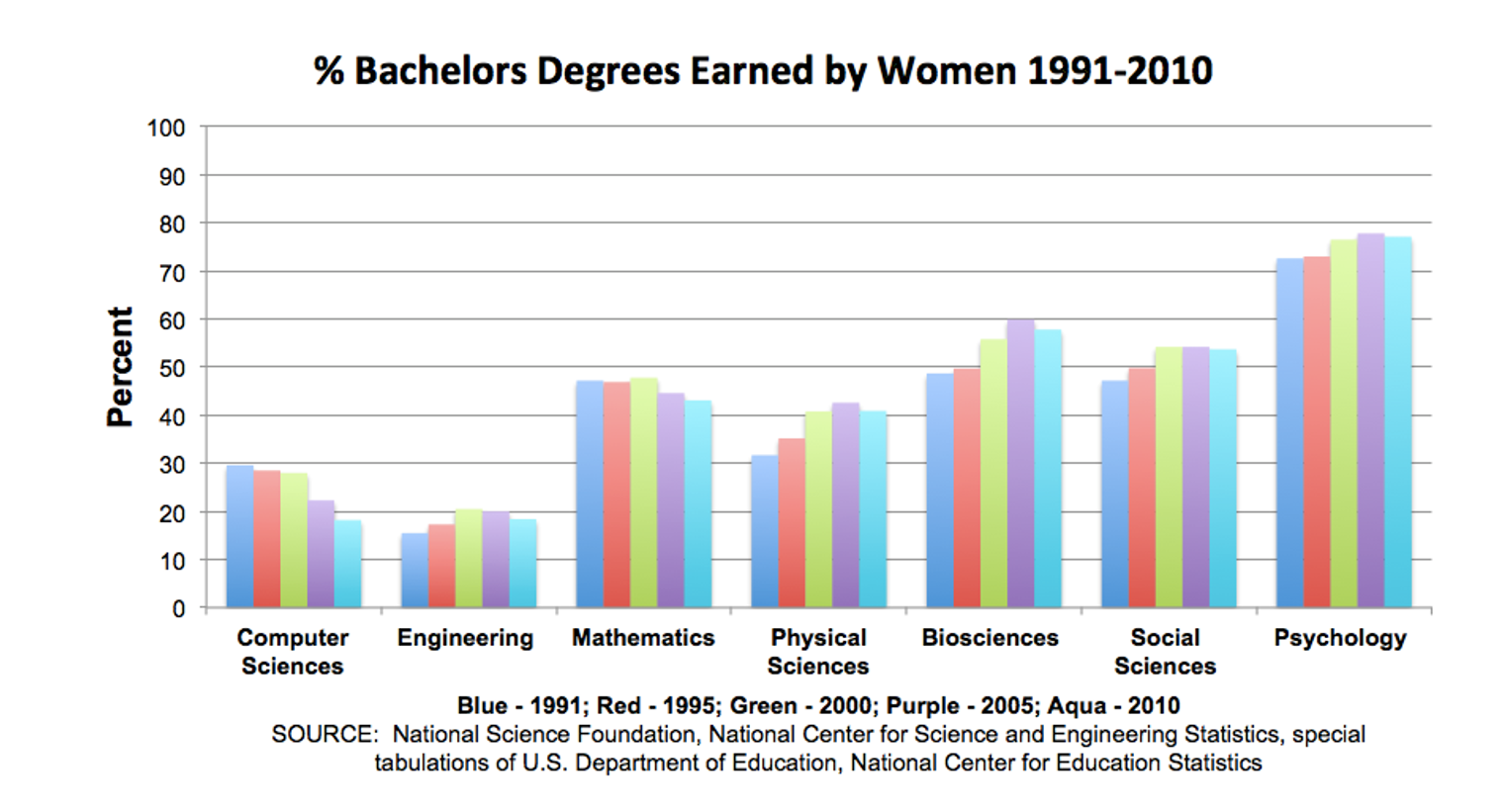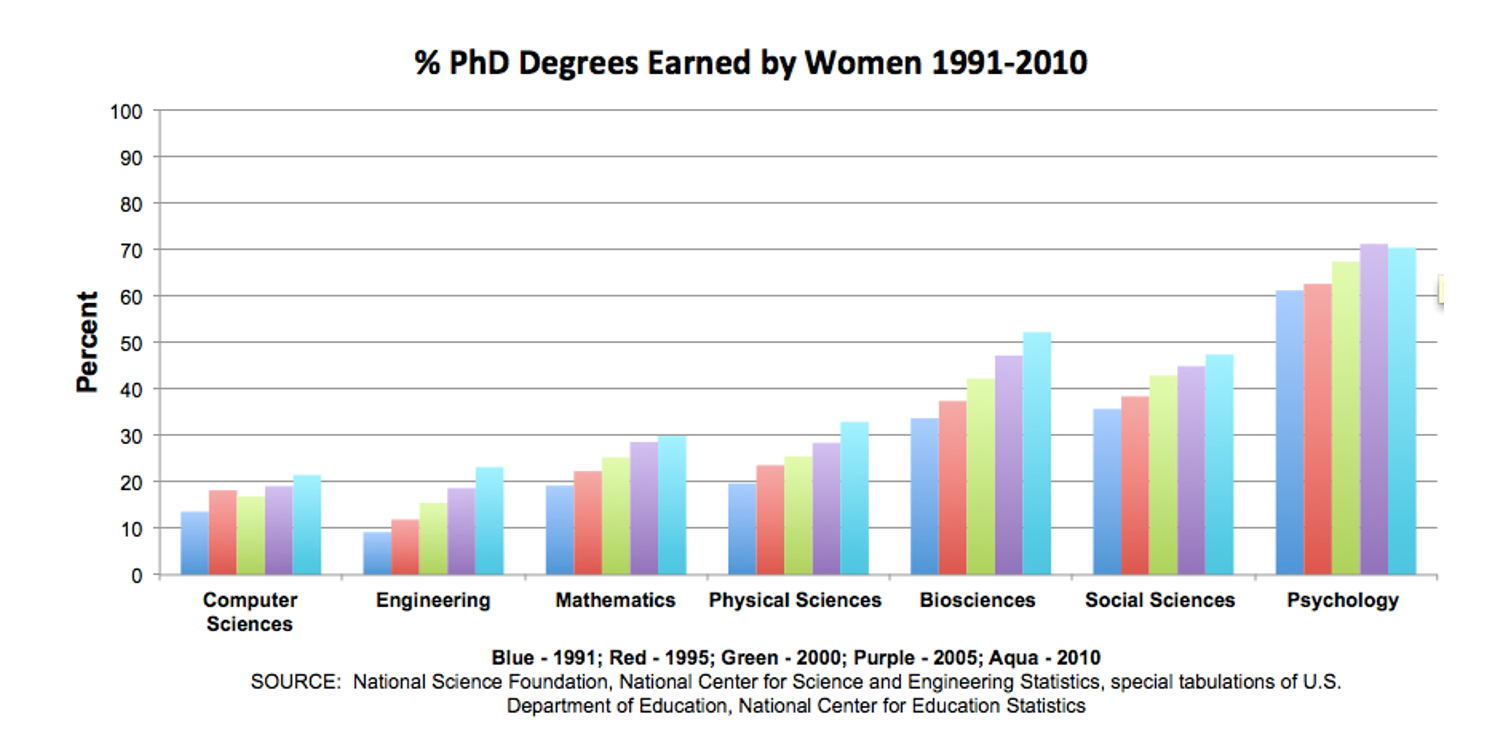[caption id="attachment_140202" align="aligncenter" width="4208"]

A new law will help girls obtain more education in math and science.[/caption] On Feb. 28, President Trump
signed into law two acts designed to encourage women toward STEM fields. The INSPIRE Act, first introduced last year by
Congresswoman Barbara Comstock (R-Virginia), asks NASA administrators to use internal programs to encourage young women to pursue STEM career paths.
The second one, the Promoting Women in Entrepreneurship Act, introduced by Congresswoman Elizabeth Esty (D-Connecticut), encourages women working in engineering, math, and sciences to branch out beyond the laboratory and into commercial fields. It asks the National Science Foundation (NSF) to use existing entrepreneurial programs for the recruitment and support of this effort. “Currently, only one in four women who gets a STEM degree is working in a STEM job,”
said President Trump. “It’s not fair, and it’s not even smart.” Calling the disparity between female STEM degree holders and those in related careers “unfair,” Trump added that protecting all Americans with such degrees is “very important.” According to a U.S. Bureau of Labor Statistics (BLS)
report published in December of 2015, women account for roughly 47 percent of the total American workforce, but hold just 26 percent of jobs in “computer and mathematical” fields. When it comes to “architecture and engineering” positions, women hold just over 15 percent of those jobs. A Harvard Business Review
study from early 2015 may shed light on why women in STEM fields are relatively few and far between. It identifies five metrics, based on interviews and surveys of over 600 female scientists, that paint a dire picture. Not only do women feel they have to unreasonably prove their worth, but they also hit glass ceilings when they decide to start a family or don’t act “masculine” enough. “There is an assumption,” a microbiologist told the Harvard Business Review, “that your career is more of a hobby than a career, and you’re only going to do it until you find a husband and/or have a family.” National Science Foundation
data backs up the Bureau of Labor Statistics findings, but asserts the disparities are largely limited to engineering and computer science fields. Other disciplines, such as science or mathematics, have much more palatable gender discrepancies. [caption id="attachment_140200" align="aligncenter" width="1521"]

Credit: PBS[/caption] PBS
compiled charts based on NSF data to show how many women complete bachelors and PhD degrees within STEM fields, highlighting one of the key points of contention. Parsing disciplines, women complete fewer degrees for computer science and engineering than they do for math or science fields (with psychology the preferred degree field by far), suggesting that the issues for women in technical fields start earlier than graduation day. [caption id="attachment_140201" align="aligncenter" width="1490"]

PhD Degrees for Women in STEM Credit: PBS[/caption] Trump signing both acts into law comes in a time of uncertainty. NASA is facing
potential budget cuts, and the White House’s ‘Women in STEM’ page is void of content. It was
stripped in early February, suggesting things related to the Office of Science and Technology (such as budget and policies) are also under review. These two acts happily trade problems for hope. They’re bipartisan, and help women already in STEM as well as girls interested in technical fields.
 A new law will help girls obtain more education in math and science.[/caption] On Feb. 28, President Trump signed into law two acts designed to encourage women toward STEM fields. The INSPIRE Act, first introduced last year by Congresswoman Barbara Comstock (R-Virginia), asks NASA administrators to use internal programs to encourage young women to pursue STEM career paths. The second one, the Promoting Women in Entrepreneurship Act, introduced by Congresswoman Elizabeth Esty (D-Connecticut), encourages women working in engineering, math, and sciences to branch out beyond the laboratory and into commercial fields. It asks the National Science Foundation (NSF) to use existing entrepreneurial programs for the recruitment and support of this effort. “Currently, only one in four women who gets a STEM degree is working in a STEM job,” said President Trump. “It’s not fair, and it’s not even smart.” Calling the disparity between female STEM degree holders and those in related careers “unfair,” Trump added that protecting all Americans with such degrees is “very important.” According to a U.S. Bureau of Labor Statistics (BLS) report published in December of 2015, women account for roughly 47 percent of the total American workforce, but hold just 26 percent of jobs in “computer and mathematical” fields. When it comes to “architecture and engineering” positions, women hold just over 15 percent of those jobs. A Harvard Business Review study from early 2015 may shed light on why women in STEM fields are relatively few and far between. It identifies five metrics, based on interviews and surveys of over 600 female scientists, that paint a dire picture. Not only do women feel they have to unreasonably prove their worth, but they also hit glass ceilings when they decide to start a family or don’t act “masculine” enough. “There is an assumption,” a microbiologist told the Harvard Business Review, “that your career is more of a hobby than a career, and you’re only going to do it until you find a husband and/or have a family.” National Science Foundation data backs up the Bureau of Labor Statistics findings, but asserts the disparities are largely limited to engineering and computer science fields. Other disciplines, such as science or mathematics, have much more palatable gender discrepancies. [caption id="attachment_140200" align="aligncenter" width="1521"]
A new law will help girls obtain more education in math and science.[/caption] On Feb. 28, President Trump signed into law two acts designed to encourage women toward STEM fields. The INSPIRE Act, first introduced last year by Congresswoman Barbara Comstock (R-Virginia), asks NASA administrators to use internal programs to encourage young women to pursue STEM career paths. The second one, the Promoting Women in Entrepreneurship Act, introduced by Congresswoman Elizabeth Esty (D-Connecticut), encourages women working in engineering, math, and sciences to branch out beyond the laboratory and into commercial fields. It asks the National Science Foundation (NSF) to use existing entrepreneurial programs for the recruitment and support of this effort. “Currently, only one in four women who gets a STEM degree is working in a STEM job,” said President Trump. “It’s not fair, and it’s not even smart.” Calling the disparity between female STEM degree holders and those in related careers “unfair,” Trump added that protecting all Americans with such degrees is “very important.” According to a U.S. Bureau of Labor Statistics (BLS) report published in December of 2015, women account for roughly 47 percent of the total American workforce, but hold just 26 percent of jobs in “computer and mathematical” fields. When it comes to “architecture and engineering” positions, women hold just over 15 percent of those jobs. A Harvard Business Review study from early 2015 may shed light on why women in STEM fields are relatively few and far between. It identifies five metrics, based on interviews and surveys of over 600 female scientists, that paint a dire picture. Not only do women feel they have to unreasonably prove their worth, but they also hit glass ceilings when they decide to start a family or don’t act “masculine” enough. “There is an assumption,” a microbiologist told the Harvard Business Review, “that your career is more of a hobby than a career, and you’re only going to do it until you find a husband and/or have a family.” National Science Foundation data backs up the Bureau of Labor Statistics findings, but asserts the disparities are largely limited to engineering and computer science fields. Other disciplines, such as science or mathematics, have much more palatable gender discrepancies. [caption id="attachment_140200" align="aligncenter" width="1521"]  Credit: PBS[/caption] PBS compiled charts based on NSF data to show how many women complete bachelors and PhD degrees within STEM fields, highlighting one of the key points of contention. Parsing disciplines, women complete fewer degrees for computer science and engineering than they do for math or science fields (with psychology the preferred degree field by far), suggesting that the issues for women in technical fields start earlier than graduation day. [caption id="attachment_140201" align="aligncenter" width="1490"]
Credit: PBS[/caption] PBS compiled charts based on NSF data to show how many women complete bachelors and PhD degrees within STEM fields, highlighting one of the key points of contention. Parsing disciplines, women complete fewer degrees for computer science and engineering than they do for math or science fields (with psychology the preferred degree field by far), suggesting that the issues for women in technical fields start earlier than graduation day. [caption id="attachment_140201" align="aligncenter" width="1490"]  PhD Degrees for Women in STEM Credit: PBS[/caption] Trump signing both acts into law comes in a time of uncertainty. NASA is facing potential budget cuts, and the White House’s ‘Women in STEM’ page is void of content. It was stripped in early February, suggesting things related to the Office of Science and Technology (such as budget and policies) are also under review. These two acts happily trade problems for hope. They’re bipartisan, and help women already in STEM as well as girls interested in technical fields.
PhD Degrees for Women in STEM Credit: PBS[/caption] Trump signing both acts into law comes in a time of uncertainty. NASA is facing potential budget cuts, and the White House’s ‘Women in STEM’ page is void of content. It was stripped in early February, suggesting things related to the Office of Science and Technology (such as budget and policies) are also under review. These two acts happily trade problems for hope. They’re bipartisan, and help women already in STEM as well as girls interested in technical fields. 


